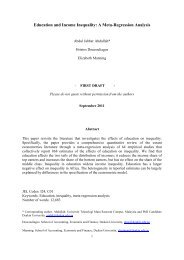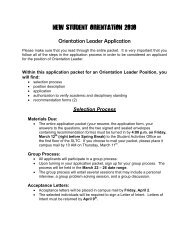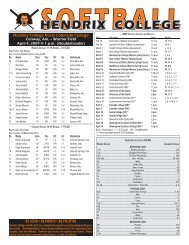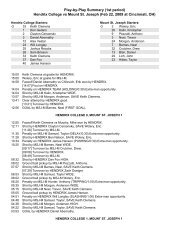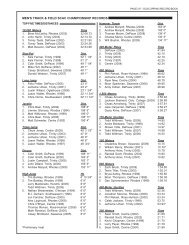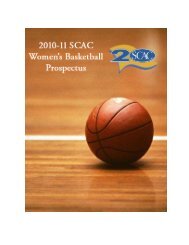Study Tips for Several Subjects - Hendrix College
Study Tips for Several Subjects - Hendrix College
Study Tips for Several Subjects - Hendrix College
Create successful ePaper yourself
Turn your PDF publications into a flip-book with our unique Google optimized e-Paper software.
Fifteen <strong>Tips</strong> <strong>for</strong><br />
<strong>Study</strong>ing Accounting<br />
by: Tom Conway, OFM<br />
1. The sequence is intentional. Keep in mind that the accounting course that you<br />
are taking is one in a sequence of courses. It has been placed where it is because<br />
that course’s material is derived from material from one or more earlier courses.<br />
Make sure that you have access to textbooks of your earlier courses. (If you’re a<br />
little bit inclined to take courses out of order, <strong>for</strong>get it!)<br />
2. The material within a given course is often sequential. This is especially true<br />
of Accounting I. That is, the material covered early in the course is necessary to<br />
do problems covered later in the course. If you don’t understand the first few<br />
chapters of the textbook, you need to go back and study those chapters be<strong>for</strong>e<br />
going on to later ones.<br />
3. Determine the scope of the course. It’s not unusual <strong>for</strong> particular chapters or<br />
particular sections of chapters to be deleted from the scope of a course.<br />
4. Practice, practice, practice. There is tremendous value in going over as many<br />
problems as you can.<br />
5. You’re trying to learn as many points as you can. If you get stuck on a<br />
particular point, don’t spend a long time trying to look it up or figure it out. Make<br />
a note of it and ask a friend or the professor about it later.<br />
6. Novels are meant to be read from beginning to end. Accounting textbooks<br />
are not. Skim the text, use the index, jump around, read the questions at the end<br />
of the chapter, look at tables and charts, cross-reference things, and notice the<br />
section headings. You’re dealing with technical language: it’s not unusual to have<br />
to read a given paragraph several times be<strong>for</strong>e you understand it.<br />
7. We’re not in Kansas anymore. In a history class, if you know 90% of the<br />
in<strong>for</strong>mation about each presidency, war, historical movement, etc., then you’ll<br />
probably be fine. In accounting, you often have to know how to finish the<br />
problem. This is especially true <strong>for</strong> multiple-choice exams. For this reason, it’s<br />
often better to completely understand some problems (and not know how to do<br />
other problems) than to have a somewhat vague notion of how to approach every<br />
type of problem. Also, having a strong understanding of one type of problem will<br />
sometimes give you a clue as to how to approach a seemingly unrelated problem<br />
that you never studied.<br />
8. Sorry to disappoint you, but accounting isn’t exactly like math. In math, the<br />
rules tend to be absolute. In accounting, many of the rules have exceptions and<br />
often the "final answer" (<strong>for</strong> example, a recommendation to a company) depends a<br />
great deal on the context of the problem.<br />
9. But wait, currency doesn’t come in negative denominations. Get in the habit of<br />
asking yourself if your final answer makes sense in the context of the problem.<br />
10. Find a partner. Spend part of your study time by yourself and part of your study<br />
time with someone else. A portion of the study time by yourself can be used to<br />
identify what things you understand and what things you don’t. You and your<br />
study partner can trade notes on this and teach each other. Studies have shown
that by teaching others you ensure that you will recall the in<strong>for</strong>mation later. The<br />
most important rule about working with someone else: keep to the task! Work<br />
hard to keep to the subject at hand. Interrupt your partner when he/she starts<br />
talking about unrelated topics.<br />
11. Learn the vocabulary. There is no quicker tip-off to the professor that you don’t<br />
know what you’re doing than using terminology inappropriately. (For example,<br />
the clueless student will typically sprinkle the term "money" liberally throughout<br />
an essay while accounting textbooks seldom use the term.) Most accounting<br />
textbooks have at least one glossary. Also, most textbooks put the key terms in<br />
boldface type. Do enough reading of the textbooks to understand how the author<br />
uses each important term.<br />
12. Don’t be fatalistic. Yes, accounting is difficult. Yes, accounting is hard work.<br />
Yes, it takes time. No, it’s not impossible. Most good students report having some<br />
breakthrough moments: times when suddenly a range of topics suddenly make<br />
sense. You might be closer than you think to having one of those breakthroughs.<br />
13. Develop a sense of curiosity. There are many rules in accounting which seem at<br />
first to be either contradictory or counterintuitive or both. Try to figure out why<br />
the rule exists and talk to other people about it. The really good students treat<br />
accounting as one big puzzle-game which they expect to win!<br />
14. Take some satisfaction in the fact that you’re doing something difficult. Even<br />
though accounting is a very marketable skill, that’s not the best reason to study it.<br />
The best reason to study accounting is that it helps develop your ability to do<br />
analytic thinking.<br />
15. Bad things happen. If nothing else motivates you to study, remind yourself that<br />
it’s very possible to get a "D" or an "F" in an accounting course. This worst-case<br />
scenario plays itself out <strong>for</strong> some students every semester. Use this fact as<br />
motivation when you are debating whether to study accounting or to go out <strong>for</strong><br />
pizza.<br />
Source: www.siena.edu/advising/accttips.htm
*<strong>Tips</strong> <strong>for</strong> <strong>Study</strong>ing Mathematics*<br />
Active <strong>Study</strong> vs. Passive <strong>Study</strong><br />
Be actively involved in managing the learning process, the mathematics and your study<br />
time:<br />
<br />
<br />
<br />
<br />
<br />
<br />
<br />
<br />
<br />
<br />
<br />
<br />
Take responsibility <strong>for</strong> studying, recognizing what you do and don't know, and<br />
knowing how to get your Instructor to help you with what you don't know.<br />
Attend class every day and take complete notes. Instructors <strong>for</strong>mulate test<br />
questions based on material and examples covered in class as well as on those in<br />
the text.<br />
Be an active participant in the classroom. Get ahead in the book; try to work some<br />
of the problems be<strong>for</strong>e they are covered in class. Anticipate what the Instructor's<br />
next step will be.<br />
Ask questions in class! There are usually other students wanting to know the<br />
answers to the same questions you have.<br />
Go to office hours and ask questions. The Instructor will be pleased to see that<br />
you are interested, and you will be actively helping yourself.<br />
Good study habits throughout the semester make it easier to study <strong>for</strong> tests.<br />
Take responsibility <strong>for</strong> keeping up with the homework. Make sure you find out<br />
how to do it.<br />
You probably need to spend more time studying per week - you do more of the<br />
learning outside of class than in High School.<br />
Tests may seem harder just because they cover more material.<br />
Take as much time as you need to do all the homework and to get complete<br />
understanding of the material.<br />
Form a study group. Meet once or twice a week (also use the phone). Go over<br />
problems you've had trouble with. Either someone else in the group will help you,<br />
or you will discover you're all stuck on the same problems. Then it's time to get<br />
help from your Instructor.<br />
The more challenging the material, the more time you should spend on it.<br />
<strong>Study</strong>ing <strong>for</strong> a Test<br />
‣ Start by going over each section, reviewing your notes and checking that you can<br />
still do the homework problems (actually work the problems again). Use the worked<br />
examples in the text and notes - cover up the solutions and work the problems<br />
yourself. Check your work against the solutions given.<br />
‣ You're not ready yet! In the book each problem appears at the end of the section in<br />
which you learned how do to that problem; on a test the problems from different<br />
sections are all together.
Step back and ask yourself what kind of problems you have learned how to solve,<br />
what techniques of solution you have learned, and how to tell which techniques<br />
go with which problems.<br />
Try to explain out loud, in your own words, how each solution strategy is used<br />
(e.g. how to solve a quadratic equation). If you get confused during a test, you can<br />
mentally return to your verbal "capsule instructions". Check your verbal<br />
explanations with a friend during a study session (it's more fun than talking to<br />
yourself!).<br />
Put yourself in a test-like situation: work problems from review sections at the<br />
end of chapters, and work old tests if you can find some. It's important to keep<br />
working problems the whole time you're studying.<br />
‣ Also:<br />
<br />
<br />
Start studying early. <strong>Several</strong> days to a week be<strong>for</strong>e the test (longer <strong>for</strong> the final),<br />
begin to allot time in your schedule to reviewing <strong>for</strong> the test.<br />
Get lots of sleep the night be<strong>for</strong>e the test. Math tests are easier when you are<br />
mentally sharp.<br />
Source: http://euler.slu.edu/Dept/SuccessinMath.html
~How to <strong>Study</strong> <strong>for</strong> a Music Class~<br />
Students should prepare a definition, description, and (or) explanation of every<br />
name, title, or term discussed in class. In essence, each should follow the principle<br />
of "who, what, when, where". This definition, description, or explanation should<br />
include each of the following:<br />
1. Brief description—one or two sentences—of what the name, title, or term<br />
represents. (This might be the sort of thing found as the first few lines of a<br />
dictionary entry <strong>for</strong> the name, title, or term. For a composer, this must<br />
include the place of birth, and locations where the composer worked,<br />
visited, and lived.)<br />
2. A date, or span of dates, that applies <strong>for</strong> the name, title, or term. This<br />
should be one or both of a specific date, or pair of dates, and an overall<br />
general description, such as "early seventeenth century".<br />
3. An indication of the place, or places where the person or item was present<br />
or active. This might include a city, a state, a country, and a continent, as<br />
appropriate.<br />
4. For terminology, an example of the item named as it normally appears in<br />
music notation.<br />
5. Examples of music, with dates, that represents the name, title, or term. For<br />
a composer, this would be music composed by the composer; <strong>for</strong> a<br />
per<strong>for</strong>mer, music per<strong>for</strong>med by that per<strong>for</strong>mer. For terminology, this<br />
would be examples of music that use the item in question. When<br />
appropriate, the examples may be very specific, including not just<br />
particular pieces, but also exact locations within individual pieces.<br />
Source: http://plato.acadiau.ca/courses/musi/callon/1293/stu-tips.htm
~<strong>Tips</strong> <strong>for</strong> <strong>Study</strong>ing Biology~<br />
<strong>Study</strong> Idea #1. Type out your notes.<br />
1. It eliminates visual distractions on the page. It makes your notes appear clean and,<br />
hopefully, concise.<br />
2. It <strong>for</strong>ces you to re-visit the material. This is especially helpful when you have not<br />
reviewed the material <strong>for</strong> awhile. You will have an easier time when you eventually sit<br />
down and try to memorize things, trust me.<br />
3. It produces a "self-test". When I sit down to type my notes, I often <strong>for</strong>mat them into<br />
two columns. One column is the "question" side, and one column is the "answer" side.<br />
This way I can cover up the "answer" column and test myself be<strong>for</strong>e the exam. Another<br />
<strong>for</strong>mat I use when typing my notes is simply to write out the question, skip a few lines of<br />
text, and then type out the answer. I quiz myself by trying to answer the questions on a<br />
piece of paper and then checking them with the typed answer.<br />
<strong>Study</strong> Idea #2.Use your artistic abilities.<br />
This idea is good <strong>for</strong> studying complex processes and detailed concepts. I start by<br />
breaking down my complicated notes into little segments of in<strong>for</strong>mation. Whenever<br />
possible I try to incorporate simple, bright illustrations. In creating these "minibillboards"<br />
of in<strong>for</strong>mation, I am able to familiarize myself with the material without<br />
getting overwhelmed by all the details. After I have come to understand the basic<br />
concepts, I build on my knowledge and start memorizing the details. Typically, this<br />
means that I turn to note-cards or my typed notes to help with memorization. But visual<br />
aids are a great way to start tackling complicated in<strong>for</strong>mation.<br />
<strong>Study</strong> Idea #3.You can learn a lot in 15 minutes.<br />
I take my notes everywhere and study them during all of life's "in-between" moments.<br />
These short study periods are helpful because the material is more familiar to me when I<br />
sit down at night to really concentrate on memorizing. A couple minutes here and there<br />
eventually add up, and when you are pressed <strong>for</strong> time, these precious snippets of<br />
studying really count.<br />
<strong>Study</strong> Idea #4.Break things up.<br />
To help break up the material and the long periods of study time, I divide my typed<br />
notes into short packets of four or five pages each. Each day I try and learn the<br />
material of one packet. As my learning progresses, I review multiple packets in one study<br />
session. To really learn the material, I normally plan out my study schedule so that I have<br />
two full days to review all of the material. This means that I have to start studying well
e<strong>for</strong>e the exam date, but I am able to walk into the classroom on the day of testing<br />
feeling very confident with my knowledge of the material.<br />
<strong>Study</strong> Idea #5. It's all about the atmosphere.<br />
Find a place that is conducive to studying. This means: 1. You want to go somewhere<br />
where you won't be interrupted. Sometimes this means getting away from webmail and<br />
telephones and the like. 2. Make sure you have plenty of pencils and paper, and that you<br />
bring your textbook along to answer any questions that may arise during the course of<br />
your studying.<br />
<strong>Study</strong> Idea #6.Go to all the review sessions.<br />
This will work <strong>for</strong> you in multiple ways. First off. your professor will know that you are<br />
serious about learning the material. Secondly, they incorporate yet another way <strong>for</strong> you to<br />
familiarize yourself with the topics under study. Review sessions are also helpful <strong>for</strong> the<br />
obvious reason that they allow you the chance to ask questions concerning material that<br />
still is unclear to you. Finally, they allow you to hear the questions of others. This is<br />
important because other students may present questions that you never thought of. I<br />
always look at review sessions as an opportunity to "polish-up" on my knowledge of the<br />
material.<br />
<strong>Study</strong> Idea #7.Write down your questions and visit your professor during office hours.<br />
Professor's are often pressed <strong>for</strong> time, especially when an exam is near. When studying, I<br />
keep a running list of questions. I make note of concepts that are still unclear to me. To<br />
answer these questions and clear up my understanding of the material, I first consult my<br />
textbook. If the textbook does not sufficiently cover my question, then I approach my<br />
professor during office hours. I bring the list of questions with me this way I am assured<br />
that all of my questions will be answered.<br />
<strong>Study</strong> Idea #8.Believe in yourself.<br />
If you have taken an active role in learning the material, then walk into the classroom on<br />
the day of the exam with a smile. You prepared yourself well. Now is the chance to show<br />
your professor how much you've learned.<br />
Source: http://biology.kenyon.edu/HHMI/Biol113/aboutme.htm
How To STUDY FOR ECONOMICS COURSES<br />
TAKING NOTES IN CLASS<br />
<br />
<br />
<br />
Be<strong>for</strong>e class: At least pre-skim related readings and review lecture notes from previous<br />
class; look at problems in the study guide; make note of new terms, concepts, measures,<br />
models, graphs, and theories; <strong>for</strong>mulate questions.<br />
During class: Have questions in mind as the lecture begins; adapt a <strong>for</strong>mat which allows a<br />
wide left-hand margin <strong>for</strong> summarizing and editing your notes plus a narrow right-hand<br />
margin <strong>for</strong> recording your own insights, questions, etc.; be alert to assumptions underlying<br />
hypotheses and note how hypotheses are tested against observational data.<br />
After class: Review and edit your notes; use the left-hand margin to summarize material<br />
and list key terms; "test" yourself as soon as possible to recall lecture highlights.<br />
READING THE TEXT<br />
<br />
<br />
<br />
<br />
<br />
Preview the material: Look at sub-headings, graphs, questions at the end of chapter; note<br />
new terms.<br />
Read actively: Formulate questions be<strong>for</strong>e you read (from lecture notes and preview) and<br />
then read to answer those questions; translate abstract concepts to specific instances;<br />
know what every term and symbol means.<br />
Analyze graphs thoroughly: What "economic story" is being told?; what are the<br />
assumptions?; note units of measurement on each axis; note direction (positive or<br />
negative) of the relationship.<br />
Recall: Test yourself immediately and cumulatively at the end of each section; then use a<br />
combination of marginal notations and underlining to summarize.<br />
Reflect: Set aside time to question and criticize what you've read — then make notes of<br />
those thoughts.<br />
PREPARING FOR EXAMS<br />
<br />
<br />
<br />
<br />
<br />
Integrate and review lecture and text notes; make a list of key topics, concepts, problems,<br />
theories, models, and terms.<br />
Review via ACTIVE RECALL rather than just passive re-reading.<br />
Re-work homework questions and workbook problems.<br />
Practice using the in<strong>for</strong>mation in the <strong>for</strong>m that will be required by the test <strong>for</strong>mat; predict<br />
test questions and problems and practice answering them.<br />
Realize that various test questions will ask you to know, comprehend, apply, and analyze<br />
what you've studied.<br />
TAKING EXAMS<br />
<br />
<br />
<br />
<br />
<br />
Glance over the whole exam quickly, assessing questions as to their level of difficulty and<br />
point value; set time goals <strong>for</strong> each section accordingly.<br />
Begin to work the questions which are easiest <strong>for</strong> you; the others will be easier when<br />
you've "warmed up."<br />
Maximize partial credit possibilities by attempting all questions.<br />
Save time at end of exam <strong>for</strong> re-reading and editing.<br />
Analyze returned tests to prepare <strong>for</strong> future ones.<br />
Source: TIhttp://www.utexas.edu/student/utlc/lrnres/handouts/1409.htmlPS
<strong>Tips</strong> on studying a <strong>for</strong>eign Language<br />
Though many students may feel they have a mental block or even lack the aptitude <strong>for</strong> learning <strong>for</strong>eign<br />
languages, most can learn a second language IF they are willing to put in the necessary time. Here are some<br />
practical suggestions <strong>for</strong> studying effectively, overcoming anxiety, and learning the grammar and skills<br />
necessary <strong>for</strong> success in college <strong>for</strong>eign language classes.<br />
1. STUDY EVERY DAY. A <strong>for</strong>eign language course is different from any other course you take.<br />
Language learning is cumulative: you cannot put it off until the weekend. <strong>Study</strong> 1 or 2 hours <strong>for</strong><br />
every class hour if you want an A or B.<br />
2. DISTRIBUTE YOUR STUDY TIME in 15- to 30-minute periods throughout the day. Focus on<br />
a different task each time: vocabulary now, grammar next, etc. Get an overview during the first<br />
half hour: spend 10 minutes reviewing dialog, 10 minutes learning new vocabulary, 10 minutes<br />
learning new grammar ... so you'll at least have looked at it all. Approximately 80% of your study<br />
time should be spent in recitation or practice, including practice in the language lab.<br />
3. ATTEND AND PARTICIPATE IN CLASS WITHOUT FAIL — even if you are not well<br />
prepared. Class time is your primary opportunity <strong>for</strong> practice. Learn the grammar and vocabulary<br />
outside of class in order to make the most of class time. Spend a few minutes "warming up" be<strong>for</strong>e<br />
each class by speaking or reading the language.<br />
4. MAKE YOURSELF COMFORTABLE IN THE CLASS. Get to know your classmates so you<br />
will feel you are among friends. Visit your instructor during office hours to get acquainted:<br />
explain your goals and apprehensions about the course.<br />
5. LEARN ENGLISH GRAMMAR IF YOU DON'T ALREADY KNOW IT. Grammar is the<br />
skeleton of a language, its basic structure: you must learn it. Review a simplified English grammar<br />
text. Compare new grammatical structures in your <strong>for</strong>eign language to their English equivalents.<br />
6. PRACTICE FOR TESTS by doing what you will have to do on the test. If the test will require<br />
you to write, then study by writing — including spelling and accents. If you will be asked to listen,<br />
then practice listening. Ask <strong>for</strong> practice questions; make up your own test questions. Invent<br />
variations on patterns and <strong>for</strong>ms. Over-learn: study beyond the point of recognition to mastery.<br />
7. DEVELOP A GOOD ATTITUDE. Have a clear personal reason <strong>for</strong> taking the class. Set<br />
personal goals <strong>for</strong> what you want to learn. Leave perfectionism at the door; give yourself<br />
permission to make mistakes and learn from them.<br />
8. GET HELP IF YOU NEED IT. Talk with your teacher. Form study groups among class<br />
members. Use tutoring services. Don't wait!<br />
READING and WRITING a <strong>for</strong>eign language are analytical skills. You may be good at these if you are a<br />
logical person who attends to detail. Train yourself through practice to notice and remember details such as<br />
accents and gender agreement.<br />
READING SKILLS TIPS:<br />
<br />
<br />
<br />
First, read the vocabulary list <strong>for</strong> the assignment. Next, read the questions over the reading. Then<br />
read all the way through a new passage two or three times, guessing at meaning from context.<br />
Avoid word-by-word translation.<br />
Isolate new vocabulary and study it separately. DON'T write between the lines! Make flash cards.<br />
Carry them with you and recite them several times during the day at odd moments. Over-learn<br />
them until they are automatic.<br />
Isolate new grammatical <strong>for</strong>ms and study them separately. Write the pattern on a flash card and<br />
memorize it. Write out and label a model sentence. When you encounter the <strong>for</strong>m while reading,<br />
pause and recite the pattern to recognize the <strong>for</strong>m.
WRITING SKILLS TIPS:<br />
<br />
<br />
<br />
Pay attention to detail: notice accents, order of letters, etc. Compare letter-by-letter different <strong>for</strong>ms<br />
(singular, plural, gender, etc.). Write out conjugations of verbs, declensions of pronouns, etc., and<br />
check your endings. Memorize irregular verbs.<br />
To master spelling, have a friend dictate 10 words to you. Write them out and immediately have<br />
your friend spell them correctly aloud while you look carefully and point at each letter. Repeat<br />
until you get all the words right.<br />
Write (in your own simple <strong>for</strong>eign vocabulary words) a story you have just read.<br />
LISTENING and SPEAKING are per<strong>for</strong>mance skills. You may do well at these if you are naturally<br />
gregarious. Students in <strong>for</strong>eign language classes often have difficulty hearing and speaking because they<br />
are anxious about making mistakes. Give yourself permission to be spontaneous and to take risks.<br />
LISTENING SKILLS TIPS:<br />
<br />
<br />
<br />
<br />
<br />
Frequent the language lab. Read the exercises in your book first; then listen and read together;<br />
then listen without looking at the print. Say aloud/write what you hear.<br />
Participate silently in class when others are called on to speak. Focus on the task; don't worry<br />
about how you'll do.<br />
If you feel nervous, relax yourself physically by taking a couple of slow, deep breaths. When<br />
called on, pause, relax, and give yourself time to respond.<br />
Listen while a friend dictates to you and write what you hear. Check <strong>for</strong> accuracy.<br />
Practice: join language clubs, watch <strong>for</strong>eign TV, listen to <strong>for</strong>eign radio.<br />
SPEAKING SKILLS TIPS:<br />
<br />
<br />
<br />
<strong>Study</strong> out loud! Mimic the sounds of the language. Don't mumble. Although most people feel<br />
embarrassed making strange sounds, the language will soon feel more familiar to you.<br />
When called on in class, say something, even it it's wrong: you'll learn from it. If you need a<br />
moment to think, repeat the question. If you don't know the answer, say in your <strong>for</strong>eign language,<br />
"I don't know" or "help!"<br />
Practice with a <strong>for</strong>eign student who wants your help to learn English or with another class<br />
member.
READING AND CRITICAL THINKING FOR<br />
UNDERGRADUATE GOVERNMENT<br />
COURSES<br />
Effective learning in an undergraduate government course depends to a great extent on your<br />
willingness to learn, to be open to diverse opinions, and to <strong>for</strong>mulate your own opinions. You do<br />
not need to have a strong background in government to per<strong>for</strong>m well in 310L or 312, <strong>for</strong><br />
example. It is more important that you gain the factual in<strong>for</strong>mation on which to build your own<br />
assessments and opinions of the political theories and practices about which you are learning.<br />
How can you gain this in<strong>for</strong>mation and become an effective student of government?<br />
CONSIDER THESE SUGGESTIONS:<br />
1. Get to know your textbook. Carefully read the introduction and preface. What is the<br />
author's background? What is his political orientation? What are his biases? What does<br />
he want you to learn by reading this book? How is the textbook organized? Look at the<br />
table of contents, the glossary, the index. How is each chapter organized and what<br />
study aids does it contain? Plan to use the organization of the text to help you study it<br />
effectively.<br />
2. What organizational pattern/patterns does the author use? Details and illustrations?<br />
Definition? Cause and Effect? An awareness of these approaches will help you to better<br />
comprehend and retain the in<strong>for</strong>mation.<br />
3. Check your vocabulary. The new vocabulary you encounter in a government course<br />
will be fundamental to your understanding. Plan on making flash cards and using them<br />
to help you review essential vocabulary.<br />
EX:<br />
laissez-faire<br />
policy of gov't<br />
non-intervention<br />
in the economy<br />
FRONT<br />
BACK<br />
4. In studying government, think about what you are reading or learning in lectures. You<br />
will often be asked to analyze, synthesize or evaluate what you are learning. Practice<br />
these skills while studying. For example: Define liberalism. How has this theory been<br />
implemented in American government? Who were its major proponents? In what ways<br />
is it workable? What have been some negative aspects of this theory?<br />
Example of analysis:<br />
ANALYSIS: By making a careful study of liberal programs, be able to state four or<br />
five of the major assumptions upon which liberalism is based — assumptions about the<br />
nature of humans and human institutions, the purpose of government, the role of<br />
government in solving social problems, etc.<br />
Example of synthesization:<br />
SYNTHESIZATION: By making a careful study of the material in the textbook on<br />
liberalism and conservatism, <strong>for</strong>mulate a system of classification in which the liberal<br />
and conservative positions on major social issues are compared.
Example of evaluation:<br />
EVALUATION: Judge the logical consistency of the liberal and conservative positions<br />
on the major social issues developed in your systems of classification.<br />
5. As you study and prepare <strong>for</strong> exams, generate general questions and then narrow<br />
them into categories where examples may fall. Professor J. Frederick MacDonald,<br />
UCLA, created the following mnemonic device to help you remember important<br />
categories:<br />
S<br />
T<br />
A<br />
M<br />
P<br />
I<br />
E<br />
R<br />
E<br />
Social<br />
Technological<br />
Administrative<br />
Military<br />
Political<br />
Intellectual<br />
Economic<br />
Religious<br />
external (<strong>for</strong>eign policy)<br />
Through categorizing, you may take a general study question such as "What are the<br />
implications of the Bakke decision of Affirmative Action programs?" and focus your<br />
answer on, <strong>for</strong> example, the social, political and economic implications of that<br />
Supreme Court decision.<br />
6. BEWARE of falling behind on your reading and/or reviewing lecture notes. It is<br />
un<strong>for</strong>tunately very easy in social sciences courses to let your assignments build up.<br />
Set aside a time early each week to get an overview of your reading assignments and<br />
break them down so that you can tackle a manageable number of pages each day,<br />
and so that you can complete relevant readings be<strong>for</strong>e they are discussed in class.<br />
Also, get into the habit of reviewing your lecture notes immediately or as soon after<br />
class as possible. The more you can learn material the first time you encounter it, the<br />
better your retention will be. Ideally, by the time you are preparing <strong>for</strong> your exams,<br />
you will be reviewing, not relearning.<br />
Prepared by Dr. Richard H. Kraemer<br />
Professor of Government<br />
The University of Texas at Austin
HOW TO STUDY MATH<br />
AND SCIENCE<br />
PREVIEWING<br />
Be<strong>for</strong>e class briefly preview the text material that will be covered in the lecture.<br />
1. Get an overview of the material by reading the introductory and summary passages,<br />
section headings and subheadings, and diagrams.<br />
2. Look at the problems at the end of the chapter.<br />
3. Make note of new terms and theorems.<br />
4. Review (if necessary) old terms and definitions referred to in the new material.<br />
5. Formulate possible questions <strong>for</strong> class.<br />
Remember, the purpose of previewing is not to understand the material but to get a general<br />
idea of what the lecture will cover. This should not be a very time-consuming process.<br />
NOTE-TAKING<br />
When taking notes in class, listen actively; intend to learn from the lecture.<br />
1. Write down the instructor's explanatory remarks about the problem.<br />
o Note how one gets from one step of the problem to another.<br />
o Note any particular conditions of the problem.<br />
o Note why the approach to the problem is taken.<br />
2. Try to anticipate the consequences of a theorem or the next step in a problem. During<br />
a proof, keep the conclusion in mind.<br />
3. Note any concepts, rules, techniques, problems that the instructor emphasizes.<br />
4. Question your instructor during class about any unclear concept or procedure.<br />
5. If you miss something in the lecture or don't understand what's being presented, then<br />
write down what you can catch — especially key words. Be sure to skip several lines<br />
so you can fill in the missing material later.<br />
6. As soon as possible after class, summarize, review, and edit your notes.<br />
o Quickly read through your notes to get an overview of the material and to<br />
check <strong>for</strong> any errors or omissions.<br />
o Fill in any in<strong>for</strong>mation — especially explanatory remarks (see #1 above) —<br />
that you did not have time to write down or that the instructor did not provide.<br />
o Use the margin or the back of the opposite page to summarize the material,<br />
list key terms or <strong>for</strong>mulas, and rework examples. You can also use this space<br />
to take notes from the textbook.<br />
o Note any relationship to previous material; i.e., write down key similarities and<br />
differences between concepts in the new material and concepts in previously<br />
learned material.<br />
7. Review your notes at regular intervals and review them with the intent to learn and<br />
retain.<br />
TEXT READING<br />
If your class lectures provide a good overall structure of the course, you can use your text to<br />
clarify and supplement your lecture notes. In order to create a single study source, insert the<br />
notes you take from the text into your lecture notes themselves as well as in the margin or<br />
the back of the opposite page.
If your text provides the best overall structure of the material, then you can use your lecture<br />
notes as the supplementary source. In either case consider the following procedures:<br />
1. Briefly preview the material. Get an overview of the content and look at the questions<br />
at the end of the chapter.<br />
2. Read actively and read to understand thoroughly.<br />
o Formulate questions be<strong>for</strong>e you read (from lecture notes or from previewing)<br />
and read to answer those questions.<br />
o Know what every word and symbol means.<br />
o<br />
o<br />
Translate abstract <strong>for</strong>mulas to verbal explanations.<br />
Analyze the example problems by asking yourself these questions:<br />
• What concepts, <strong>for</strong>mulas, and rules were applied?<br />
• What methods were used to solve the problem? Why was this method<br />
used?<br />
• What was the first step?<br />
• Have any steps been combined?<br />
<br />
What differences or similarities are there between the examples and<br />
homework problems? Further analyze the example problems by using the<br />
following procedures:<br />
• Explain each step using your own words. Write these explanations on<br />
paper.<br />
• Draw your own diagrams to illustrate and explain problems.<br />
• For practice, write down example problems from your book, close your<br />
book, and try to work the problems. Check your work with the<br />
example to find what concepts, rules, or methods you are having<br />
trouble with.<br />
o Check to see how the material relates to previous material. Ask yourself these<br />
questions:<br />
• How was the material different from previous material?<br />
• How was it the same?<br />
• What totally new concepts were introduced and how were they<br />
applied?<br />
• Where does this material "fit" within the overall structure of the<br />
course?<br />
3. Stop periodically and recall the material that you have read.<br />
4. Review prerequisite material, if necessary.<br />
PROBLEM SOLVING<br />
Solving problems is usually the most important aspect of math or science courses. You must,<br />
there<strong>for</strong>e, spend much of your study time either working or studying problems. When working<br />
a problem, follow these steps:<br />
1. Read through the problem at a moderate speed to get an overview of the problem.<br />
2. Read through the problem again <strong>for</strong> the purpose of finding out what the problem is<br />
asking <strong>for</strong> (your unknown). Be able to state this in your own words.<br />
3. If appropriate, draw a diagram and label the givens.<br />
4. Read each phrase of the problem and write down (symbolically or otherwise) all<br />
in<strong>for</strong>mation that is given.<br />
5. Devise a tentative plan to solve the problem by using one or more of the following<br />
tactics:<br />
o Form relationships among all facts given. (Write an equation that includes your<br />
unknown.)<br />
o Think of every <strong>for</strong>mula or definition that might be relevant to the problem.
o Work backwards; ask yourself, "What do I need to know in order to get the<br />
answer?"<br />
o Relate the problem to a similar example from your textbook or notes.<br />
o Solve a simpler case of the problem using extremely large or small numbers;<br />
then follow your example as if it is an example from the text.<br />
o Break the problem into simpler problems. Work part of the problem and see if<br />
it relates to the whole.<br />
o Guess an answer and then try to check it to see if it's correct. The method you<br />
use to check your answer may suggest a possible plan.<br />
o If you are making no progress, take a break and return to the problem later.<br />
6. Once you have a plan, carry it out. If it doesn't work, try another plan.<br />
7. Check your solution.<br />
o Check to see if the answer is in the proper <strong>for</strong>m.<br />
o Insert your answer back into the problem.<br />
o Make sure your answer is "reasonable."<br />
During the problem solving process, it is often helpful to say out loud all of the things you are<br />
thinking. This verbalization process can help lead you to a solution.<br />
PROBLEM ANALYSIS<br />
After you have worked a problem, analyze it. This can help sharpen your understanding of the<br />
problem as well as aid you when working future problems.<br />
1. Focus on the processes used (not the answer) and ask yourself these questions:<br />
o What concept, <strong>for</strong>mulas, and rules did I apply?<br />
o What methods did I use?<br />
o How did I begin?<br />
o How does the solution compare with worked examples from the textbook or<br />
my notes?<br />
o Can I do this problem another way? Can I simplify what I did?<br />
2. Explain each step using your own words. Write these explanations on your paper.<br />
TEST PREPARATION<br />
If you have followed an approach to study as suggested in this handout, your preparation <strong>for</strong><br />
exams should not be overly difficult. Consider these procedures:<br />
1. Quickly review your notes to determine what topics/problems have been emphasized.<br />
2. Look over your notes and text. Make a concept list in which you list major concepts<br />
and <strong>for</strong>mulas which will be covered.<br />
3. Review and rework homework problems, noting why the procedures applied.<br />
4. Note similarities and differences among problems. Do this <strong>for</strong> problems within the<br />
same chapter and <strong>for</strong> problems in different chapters.<br />
5. Locate additional problems and use them to take a practice test. Test yourself under<br />
conditions that are as realistic as possible (e.g., no notes, time restriction, random<br />
sequence of problems, etc.). Also try to predict test questions; make up your own<br />
problems and practice working them.<br />
TEST TAKING<br />
1. Glance over the whole exam quickly, assessing questions as to their level of difficulty<br />
and point value. Also get a sense of how much time to spend on each question. Leave<br />
time at the end to check your work.<br />
2. Begin to work the problems which seem easiest to you. Also give priority to those<br />
problems which are worth the most points.
3. Maximize partial credit possibilities by showing all your work.<br />
4. If you have a lapse of memory on a certain problem, skip the problem and return to it<br />
later.<br />
TEST ANALYSIS<br />
Analyzing returned tests can aid your studying <strong>for</strong> future tests. Ask yourself the following<br />
questions:<br />
<br />
<br />
<br />
<br />
Did most of the test come from the lecture, textbook, or homework?<br />
How were the problems different from those in my notes, text, and homework?<br />
Where was my greatest source of error (careless errors, lack of time, lack of<br />
understanding of material, uncertainty of which method to choose, lack of prerequisite<br />
in<strong>for</strong>mation, test anxiety, etc.)?<br />
How can I change my studying habits to adjust <strong>for</strong> the errors I am making?<br />
IMPORTANT: The knowledge of most math/science courses is cumulative. Many concepts build<br />
on previous concepts, and a poor understanding of one concept will likely lead to a poor<br />
understanding of future concepts. Consequently, you should seek help early, if you encounter<br />
difficulty.<br />
Source: University of Texas at Austin Learning Center







